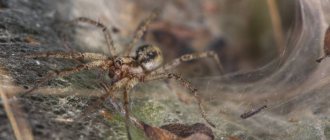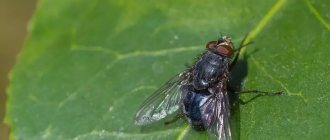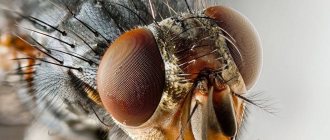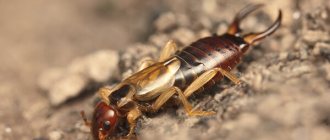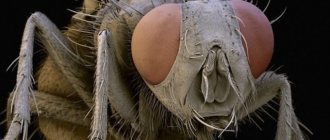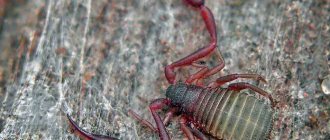The cross spider is a representative of the most common species, which is found in almost all regions except northern and southern latitudes. It prefers places with high humidity and is most often found in gardens, fields, among shrubs growing near water bodies, as well as in groves and forests. It can also live on the eaves of buildings and on the facades of buildings.
Description and appearance
Male crusader spiders grow up to 1 cm in length, but females are larger. Adult females can have a body up to 2-4 cm long. The body consists of a round, convex abdomen and cephalothorax. The spider's body is protected by a durable shell, and many fibers can be seen on its legs. The spider has 4 pairs of walking legs, and the first pair performs many functions: the spider uses this pair of legs to capture and hold its prey. The paws are symmetrically located in relation to the body. The body structure is no different from other species of arachnids. A thin bridge passes between the abdomen and cephalothorax.
The cross spider has 8 eyes, which are located on the front of the head, with 6 of them located in the center, and 2 large eyes at the edges of the head. A large number of eyes helps the spider see almost everything that happens around it, but the spider does not have very good vision.
Interesting to know! Spiders are nearsighted, so they can see silhouettes, shadows or movement. Spiders navigate in space using their senses of smell and touch. When a spider finds itself in an unfamiliar place, it first examines everything around with the help of its legs and only then begins to move in space.
The appearance of crusader spiders corresponds to a specific species. As a rule, spiders can differ either in size or body color. It makes sense to pay attention to these most common types:
- The meadow crusader prefers to live in places where there is enough moisture, warmth and some sunlight. The spider's body may have a brown, yellow or red tint. On the top, on the back, there are white spots in the shape of a cross. Thanks to this form of the pattern, all types of this spider belong to the crusader spiders. The meadow cross weaves a web in the grass to catch small insects.
- The forest crusader , unlike the meadow crusader, has a darker color of its body, which is distinguished by a dark brown color with the presence of white stripes. On the top of the abdomen and on the back you can see a distinct white or brown cross. This spider has quite long legs. It is considered the largest cross spider that is found in our area. Its size reaches 4 cm including the legs.
- The Far Eastern crusader has quite impressive dimensions. Habitats are forests, meadows, and fields. It has a brown body color and various shades. The cross is white or yellowish in color. The web woven by this spider reaches a size of about 2 meters in diameter. Frogs, snakes and other small animals become entangled in its strong web.
- A predatory spider with a red cross on its back is one of the varieties of the meadow cross. With the help of bright spots, the spider scares away natural enemies, but this does not mean that this species is more poisonous.
- The yellow or orange crusader spider is a species of common crusader. Prefers to live in shady areas of forests, fields, meadows, gardens, etc. It is considered a rather rare species and is therefore listed in the Red Book. Grows up to 1.8 cm in length.
- The black crusader prefers to live within swamps, forests, and fields, and is rarely found near humans. This spider has a white cross on its back. Many people confuse this species of crusaders with tegenaria.
These arachnids have a unique cross pattern on their back, which is the reason for their name.
Spider is a cross. Class Arachnida. Biology Lessons Online
What does the cross spider eat?
All spiders with a cross are predators. They obtain food using webs. Arthropods can wait for prey in a shelter or be in the center of a woven network, as well as next to it. They feed on insects (flies, leafhoppers) and other small arthropods. The prey is captured with the tentacles and poisonous secretions and digestive juices are injected into the wound. The protostomed animal leaves its prey for about an hour under the influence of poison. Later it returns and sucks out the contents of the insect using a sucking stomach.
Ticks
Protostomes belong to the subclass Arachnids. Previously considered the largest order after Araneae. They feed on decaying organic material and the sap of agricultural crops. The victim of the tick can be herbivorous fellows or thrips. Ticks and crosses do not touch each other.
flies
Without exception, all species of the arachnid class feed on flies. Diptera fly up to the web and stick to it. Arachnids pick up the vibration and approach the victim. In order for the dipteran to fly away, additional threads are wrapped around it, interrupting its breathing.
The forelimbs have chalicerae (oral appendages), consisting of thick and short segments. Each of them has a movable claw and a hole through which the poisonous secretion of the glands is released.
After being bitten by a spider, the insect is immobilized. The toxin that gets inside liquefies the insides of the fly. After some time, the spider sucks out the liquid contents of the dipterans.
Arachnids are afraid of flies and wasps flying towards them. They wait until they are completely entangled in the nets, and only then do they approach. But there are flies that fly up to a spider frozen in anticipation of a victim and lay eggs on its back. The name of the insect is Melanophora roralis.
Aphid
Aphids are small-sized hemipteran arthropods. On average, they reach 5-7 mm. They feed on plant juices of young plant shoots. They secrete sweet nectar that attracts various insects.
The cross makes a web in places with a large concentration of flies that have flown in on the sweet smell. Araneus and aphids naturally prefer areas with dense vegetation. The primordial animal weaves new nets almost every day, and aphids inevitably get caught in them.
Beetles
Beetles belong to the order of invertebrates and have highly sclerotized wings used for flight. They have a variety of sizes - from 0.3 to 171 mm. Large individuals, when flying or running, easily tear apart the web. And small ones are often caught in nets, turning into food for arachnids.
Mosquitoes
Representatives belong to the family of Diptera arthropods. They are widespread throughout the globe. The peculiarity of their diet forces them to settle next to humans. Insects swarm and fly to illuminated areas. It is in such conditions that the crosser sets up his nets. Mosquitoes are small and light; they rarely break webs, and therefore often become prey.
Natural habitats
Crusader spiders live throughout the Eurasian continent, including North America. These spiders love high humidity, high temperature and lack of sunlight. Spiders are found mainly in forests, on the edges of forests, in meadows, fields, gardens, etc. On our territory there are up to 30 species of crusader spiders.
Important point! In a human home, this spider weaves a web in places where there is little light and no noise. These can be far corners, both at the top and bottom of the room, as well as behind furniture. Its diet includes flies, cockroaches and other harmful insects. To get rid of such an unpleasant neighborhood, you can remove the web and throw it along with the spider outside, although the spider does not pose a danger to humans.
Lifestyle
The natural habitats of crusader spiders are their natural environment, but they can often be found in human homes. They show their main activity at night, and during the day they prefer to hide in their shelters. Therefore, the spider weaves its web at night. Being in the natural environment, the spider builds itself a house from leaves, and weaves a web in the spaces between the trees.
The web of the cross is a rather complex engineering structure, consisting of 39 radii of various sizes, 35 spiral turns, as well as 1245 points of contact of the threads. As mentioned above, some species can weave webs up to 2 meters in diameter.
Interesting fact! The spider weaves a web at night, and during the day it works, that is, the victim gets caught in it. If the web is damaged, the spider repairs it or weaves a new one. The diet of birds also includes spiders, but at night the birds rest, so the spiders go out hunting.
Experts say that spiders can live for about 2 years, although in the natural environment rarely do any spiders manage to live even 2 years due to the presence of natural enemies. In home conditions close to natural conditions, the spider can easily live up to 2 years.
Description of the arachnid
The arachnid represents the genus of araneomorphs, with a cross depicted on the abdominal region. It stands out in a lighter color than the color of the arthropod’s abdomen. The cross often has a light brown tint. Compared to other representatives of the genus, it is small in size. The spiders themselves have yellowish or brown tints, but depending on their location they may have:
- orangeish;
- red-brown;
- whitish;
- gray shades.
Changing color is a function that helps them hide from enemies. The brightness of its color depends entirely on its habitat. There are individuals of brighter and darker tones. With its pattern, the orb weaver makes it clear to other animals that it is better not to mess with it. The size of the individual reaches 3.8-4.0 cm. Males are somewhat smaller and reach sizes of no more than 1-1.2 cm.
Please note! The female is much wider than the male and has a larger appetite. Has 4 pairs of legs and eyes.
The legs of the arachnid are poorly developed, which does not prevent them from moving quickly. There are claw-like serrations that help them grip their prey more firmly. The legs have many hairs that help it navigate in space. This function was not introduced by nature by chance - after all, the spider’s eyes practically do not give it a clear image. His level of vision is nearsighted and he sees shadows and silhouettes. The head is united with the thoracic part of the body, round in shape. The body is protected by a shell, which is covered on top with a protective lubricant.
Characteristics of the individual
In addition to legs, the arachnid has 4 more limbs. A pair of them are called chelicerae. Chelicerae are provided by nature to make it convenient for the spider to capture prey and, by connecting them, kill it. The second pair are pedipalps. They are needed to catch prey.
Having killed the prey, he must inject poison into the victim. The spider weaves the cocoons themselves using special spider warts. He has a total of 6 of them. Thanks to this variety and network, he can weave different ones. During molting, it has the peculiarity of shedding its chitinous shell. The individual is also interesting because it has claws in its mouth. With them it is much easier for the arachnid to obtain food.
Distribution and food places
The crusader is distributed almost throughout the globe. The main thing for its existence is the presence of a humid environment. Successfully live in:
- Europe and Asia;
- Russia;
- America;
- CIS countries;
- Northern part of Africa.
For the location of deployment, it selects places exposed to high temperatures and poorly transmitting sunlight. For example, forest plantations, forests, shrubs, gardens and other plantings. If the house is humid, it can use it as a shelter. Once in a house or bathhouse, it chooses a dark place and spins a web during the night.
It feeds on living creatures that fall into the woven web. Loves small insects, but sometimes can feed on large ones. In particular, it loves mosquitoes, flies and midges. The crosser can release excessively large animals in peace, interrupting the weaving. It does not eat all individuals, rejecting some. For example, those whose poison can harm him.
Please note! He eats a lot, has a high daily requirement, exceeding his own weight.
Web
The web is weaved at night, because the birds (enemies) are sleeping at this moment. Performs work daily. The spider does not weave a web only on those days when it remains intact and does not have holes.
Makes it in the form of a wheel, between two bases. Arranged from top to bottom, it includes two types of threads. Some of them stick, others don't. Sticky threads serve to catch insects; non-sticky threads subsequently play the role of a cocoon from which the cross spider feeds. The arachnid itself is located in the center of its creation, but can sometimes hide, allowing the web to remain empty.
It weaves a web, making it symmetrical and elastic. The spider feeds externally. Completely, his body is not able to digest its victim. Sensing that prey has fallen into the web, he injects his juices into it and waits. Once his substance has digested it, he can feed on the finished cocktail.
Arachnids and humans
A spider can bite, but people have long used spider webs to make some fabric household items. Now people are actively using the crusader thread:
- For precise measurements in the optical field. Engineers use it in the production of devices.
- Has disinfecting properties.
- Used as fabric and accessories.
- They make items that require strong threads. For example, fishing equipment.
- Helps determine the composition of air.
It also has great benefits in nature - it helps eliminate pests.
Diet
The diet of the crusader spider consists of various insects such as flies, wasps, hornets, grasshoppers, locusts, caterpillars, butterflies, etc. Snakes, mice, frogs, etc. get entangled in large webs woven from strong threads.
The spider does not have an internal digestive system, so it consumes liquefied food. After a spider bite, when the spider injects a portion of poison, the victim is immobilized. At the same moment, he injects a special secretion into the victim, which turns solid tissue into a liquid mass. After about 20 minutes maximum, the spider starts eating.
Reproduction process
The reproductive process in spiders begins at the end of summer. Mating occurs directly on the web, after which the female forms a cocoon and lays more than 200 eggs in it.
First, the female carries the cocoon with her, and after a while leaves it in a suitable place. In this cocoon, the future offspring overwinter and only in the spring in April the young are born.
Spiders grow and develop over several months, molting at least 5 times during this time. By the end of summer, young spiders are ready to continue their race. The young animals feed on caterpillars all this time.
Important point! Adult spiders look for suitable places to spend the winter. Such places can be cracks in the walls of various outbuildings, forest litter, and tree hollows. When the air temperature begins to rise in the spring, spiders begin to leave their shelters.
Mating season and reproduction of crosses
Males wander in search of the female and her web. Having found a suitable one, the male weaves a thread for himself at the edge of the web, so that when the female notices him, he can slide down it and not be eaten. When the female realizes that it is not the prey that is giving her signals, but the male, she moves towards him and mating occurs, after which the male dies. The female begins to weave a cocoon in which she will lay eggs and hide them in a safe place. All this usually happens at the end of autumn. The spiders appear in the spring, become sexually mature by the end of summer, after which the female mother dies.
Crosses are not dangerous or poisonous. However, you should definitely not abuse their patience.
Is the crusader spider dangerous for humans?
The spider's venom is toxic enough to immobilize a potential victim. For various types of insects, as well as invertebrates, the venom of the crusader spider is fatal, but animals such as sheep, horses, dogs, and guinea pigs are quite resistant to the venom of the crusader spider. Only a short-term deterioration in health is possible.
This spider does not pose a danger to humans; moreover, when it sees a person, it tries to hide in a nearby shelter. But if you try to catch it, it may bite, after which 2 small spots appear on the body. Pain and burning may appear immediately, and the next day the wound may fester. People with weakened immune systems, as well as children, may experience a deterioration in their overall health after being bitten. The result is general weakness, nausea, headache, dizziness, and abdominal discomfort. After a few days, the victim’s condition returns to normal.
Cross spider and interesting facts about it
Symptoms of a bite and what to do
The first signal of a bite is a sharp throbbing pain. After a while it disappears, replaced by a burning sensation. The bite site begins to itch and may become red or swollen. In the affected area, two spots are visible through which the bite was made. Depending on the amount of poison injected, dizziness, drowsiness, general weakness and nausea may occur. A person may vomit.
Despite the fact that the cross is poisonous, it does not pose a danger to human life. It is dangerous for insects and some living creatures. For example, mice and rats. Larger animals will remain alive after being bitten. A person can be bitten if he accidentally gets into the area where the web is located, or if he picks it up. In other cases, the arthropod will try to avoid contact with humans. Its appearance is also designed to scare away enemies. The bite of a cross spider has its own symptoms, which are unpleasant for humans. However, they do not pose any particular danger.
Please note! Introduced through the wands, the toxic substance leaves the human body after a few days. But still, in order to avoid being bitten, it is better to follow the rules of prevention.
Even if you don’t have a photo of an arthropod at hand, you can recognize it by its chitinous shell and characteristic pattern on its abdomen. First of all, you shouldn’t panic – no one died from the crusader’s bite! The person who has been bitten should correctly assess his condition. If you suspect that the lesion has serious consequences, consult a doctor. Most often this is necessary for people suffering from allergies. The risk group also includes the elderly and children. In 99% of cases, medical intervention is not required and standard first aid methods can be used.
First aid for a spider bite:
- Wash your hands well with laundry soap. If you don’t have it at hand, any other will do. The water should not be hot.
- Use cryotherapy by applying ice or a very cold object to relieve swelling and swelling.
- Take an antipyretic drug. An appointment is not necessary, but at the slightest deterioration in health, it is better to play it safe. Paracetamol can be used.
- Keep the wound clean and calm.
If your condition worsens, you should visit a doctor. Allergy sufferers are at risk, so it is better to take antihistamines that are appropriate based on your medical history. For example, Fenistil or Suprastin. If the victim is an elderly person or a child under 14 years old, you should consult a doctor! The poison may be dangerous for children under 5 years of age.
